Project Activities | Itinerary | Price | TRIP REVIEWS | Trip reports | Safety
Volunteer in the Galápagos Islands!
The Galápagos Islands are a rare and distinctive collection of volcanic islands located 600 miles off the coast of Ecuador in the Pacific Ocean. The combination of hot equatorial sun and cool ocean waters has nurtured rich marine and terrestrial environments. The islands are known for the unique variety of animals which inspired Darwin and continue to fascinate visitors today.
 Be inspired by Darwin and the giant tortoises for which the islands were named. Travel slowly and carefully observe as you help care for the Galápagos Islands. Travelers on our Galápagos trip support sea turtle research and improve habitat protection for the giant tortoise. Join our Galápagos volunteer trip to make a difference in this remarkable place!
Be inspired by Darwin and the giant tortoises for which the islands were named. Travel slowly and carefully observe as you help care for the Galápagos Islands. Travelers on our Galápagos trip support sea turtle research and improve habitat protection for the giant tortoise. Join our Galápagos volunteer trip to make a difference in this remarkable place!
Our June 2025 trip is now complete. If you want to be notified when our next volunteer trip to Galapagos is available, please click on the button below:
Our volunteers in the Galápagos Islands help to protect the wildlife that makes the Galápagos such a unique place, while engaging in rewarding and memorable experiences. 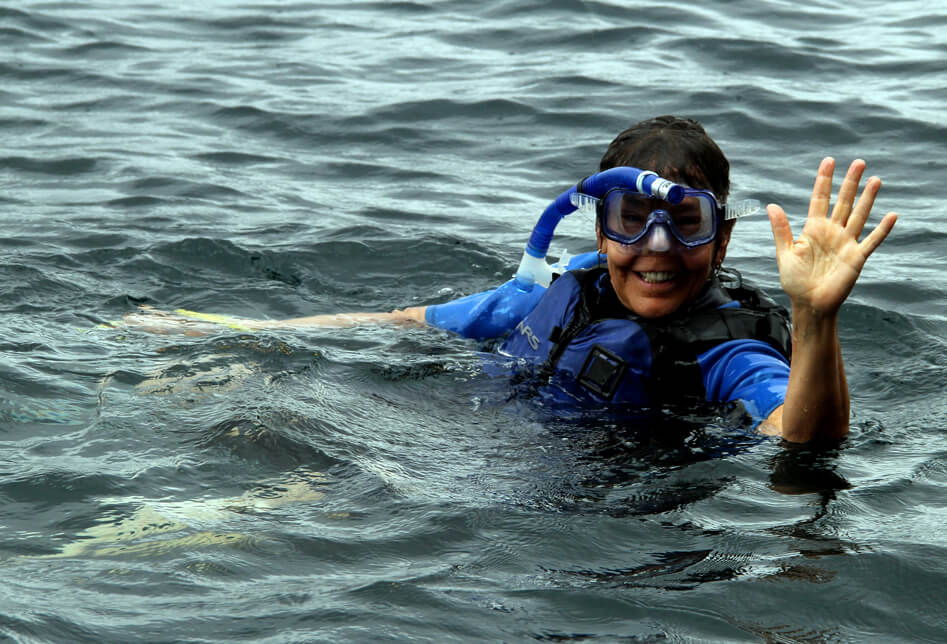 Volunteers will work on important conservation projects including sea turtle research and habitat protection for the giant tortoise. We train you in all aspects of the work. As always, your education and safety are priorities.
Volunteers will work on important conservation projects including sea turtle research and habitat protection for the giant tortoise. We train you in all aspects of the work. As always, your education and safety are priorities.
Tasks vary, but you should have intermediate swimming skills, and be able to hike up to three miles a day on uneven trails, move soil or rock with a shovel, pull unwanted vegetation, and carry stones. You may:
- snorkel while photographing sea turtles
- assist in collecting and collating data about turtles
- help improve habitat in a tortoise sanctuary
The Galápagos Islands is a wonderful place to volunteer. Conservation Volunteers International Program is pleased to offer this exciting opportunity to protect an international treasure.
Your Galápagos Islands Volunteer Trip is focused on helping to protect the wildlife that makes the Galápagos such a unique place, while at the same time providing a rewarding and memorable experience.
Day 1: Our volunteer trip begins in the Galápagos Islands at 2:00 PM at our hotel on San Cristóbal Island.
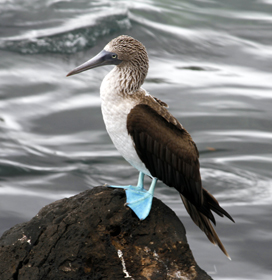 We will have an orientation and briefing at the hotel beginning at 2:00 PM where you will meet the other volunteers, the trip leaders from Conservation Volunteers International Program and our local guide. Then we will visit the Interpretive Center at Darwin Bay for an introduction to the history of the Galápagos and the flora and fauna of the island, followed by our first group dinner. (Dinner and hotel lodging included.)
We will have an orientation and briefing at the hotel beginning at 2:00 PM where you will meet the other volunteers, the trip leaders from Conservation Volunteers International Program and our local guide. Then we will visit the Interpretive Center at Darwin Bay for an introduction to the history of the Galápagos and the flora and fauna of the island, followed by our first group dinner. (Dinner and hotel lodging included.)
Day 2: Visit a giant tortoise breeding center and photograph sea turtles!
 In the morning, we visit the Centro de Crianza de Tortugas, which is part of the Galápagos National Park’s semi-natural breeding program for giant tortoises, to begin familiarization with giant tortoises. In the afternoon, the group will have its first of several experiences snorkeling while photographing sea turtles, to provide data to the sea turtle research project conducted by the University of San Francisco de Quito. (All meals and lodging included.)
In the morning, we visit the Centro de Crianza de Tortugas, which is part of the Galápagos National Park’s semi-natural breeding program for giant tortoises, to begin familiarization with giant tortoises. In the afternoon, the group will have its first of several experiences snorkeling while photographing sea turtles, to provide data to the sea turtle research project conducted by the University of San Francisco de Quito. (All meals and lodging included.)
Days 3 – 4: Continue support for the sea turtle research.
We will meet with the researchers from the Galápagos Science Center, University of San Francisco de Quito to learn about the purpose and importance of our sea turtle volunteer project.
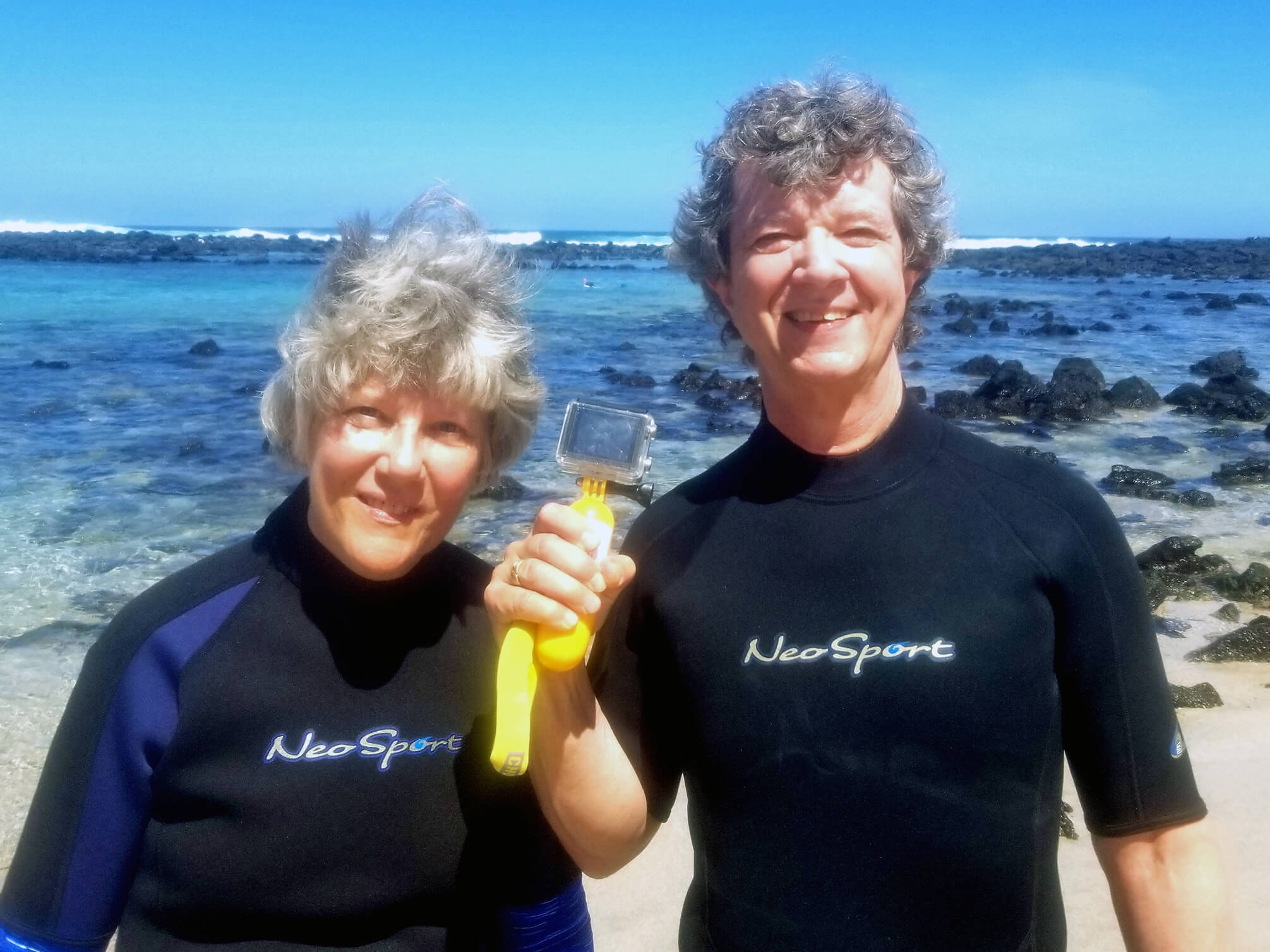 We will be participating in a survey and census of sea turtles as part of ongoing research on the impacts of increased boat traffic on sea turtles. On this trip you will have several opportunities to photograph turtles while snorkeling at different sites, to help identify the individuals by their unique markings, patterns and any injuries, and provide other onshore assistance with the survey.
We will be participating in a survey and census of sea turtles as part of ongoing research on the impacts of increased boat traffic on sea turtles. On this trip you will have several opportunities to photograph turtles while snorkeling at different sites, to help identify the individuals by their unique markings, patterns and any injuries, and provide other onshore assistance with the survey.
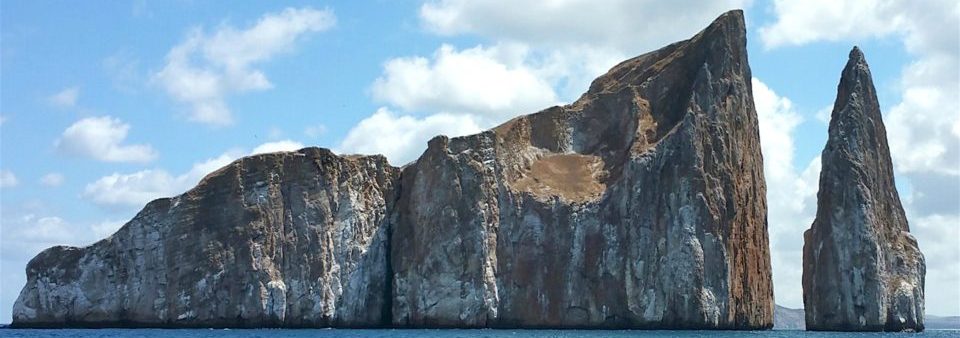 Most snorkeling sites are close to shore, although one of the sea turtle research projects will involve taking a boat to the research site near Kicker Rock with surface snorkeling in water that is too deep to touch or see the ocean bottom. Flotation devices will be provided and are required. (All meals and lodging included.)
Most snorkeling sites are close to shore, although one of the sea turtle research projects will involve taking a boat to the research site near Kicker Rock with surface snorkeling in water that is too deep to touch or see the ocean bottom. Flotation devices will be provided and are required. (All meals and lodging included.)
Day 5: Air shuttle to Isla Isabela, visit the giant tortoise breeding center on Isla Isabela, bike to the Wall of Tears.
We will spend the morning shuttling by small plane from San Cristóbal to the largest island in the Galápagos, Isla Isabela.
We will check into our hotel in the village of Puerto Villamil where we will spend our first two nights on Isla Isabela. Those who arrive on an early shuttle will have time to explore the nearby coastline (look for marine iguanas!) while the others are transferring to Isabela.
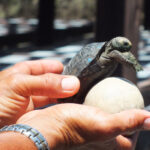 In the afternoon we will visit nearby Centro de Crianza, the Tortoise Center of Isabela, and learn about the National Park’s captive breeding program. The Center houses several species of tortoise, and we will see both hatchlings and the older breeding animals. Before dinner we will mountain bike to the Wall of Tears. Watch for a diversity of birdlife along the way! The wall, towering 65 feet in places, was constructed in the 1940’s by convicts when Isabela was a penal colony. We will have dinner after we return to our hotel in Puerto Villamil. (All meals and lodging included.)
In the afternoon we will visit nearby Centro de Crianza, the Tortoise Center of Isabela, and learn about the National Park’s captive breeding program. The Center houses several species of tortoise, and we will see both hatchlings and the older breeding animals. Before dinner we will mountain bike to the Wall of Tears. Watch for a diversity of birdlife along the way! The wall, towering 65 feet in places, was constructed in the 1940’s by convicts when Isabela was a penal colony. We will have dinner after we return to our hotel in Puerto Villamil. (All meals and lodging included.)
Day 6: Boat to Tintoreras for sea turtle survey, then move to an eco-camp for our Galápagos giant tortoise project.
In the morning, we will hop a boat to the islet of Tintoreras, where we conduct a sea turtle census. Watch for sea lions, turtles, marine iguanas, rays and sharks in the crystal blue waters!
After we return to shore, we transfer to Campo Duro Eco-Camp, in the foothills of the Sierra Negra Volcano, for our Galápagos giant tortoise project. Campo Duro works in concert with Galápagos National Park, providing a reserve to help raise giant tortoises from 3 to 8 years old. In the afternoon we will be oriented to the projects at Campo Duro and work on projects which may include planting and weeding tortoise enclosures; building a pond for the tortoises; repairing and building enclosure fences; and working in the organic garden.
Campo Duro is set in the cooler lush, tropical highlands. We will spend the night at Campo Duro. Amenities include fully equipped sleeping tents with mattresses and bedding, outdoor private cold-water showers, bathrooms with flush toilets, and an open-air thatched roof restaurant and bar. Most of the fruits and vegetables served are grown organically in the on-site gardens. Food is cooked in wood-fired stone ovens. (All meals and lodging included.)
Day 7: Galápagos giant tortoise habitat project and visit Sierra Negra volcano.
After finishing our tortoise habitat projects at the eco-camp, we will drive through the highlands, where giant tortoises feed on the abundant vegetation, to the slopes of the Volcan Sierra Negra. Our moderate 9-mile hike takes us through rugged terrain which ends at the stunning caldera, the second largest intact crater in the world after the Ngorongoro Crater in Tanzania. We will return to the hotel in Puerto Villamil at the end of the day. (All meals and lodging included.)
Days 8: Sea Turtle Research at the Tunnels
After breakfast we will be transported by boat to Los Tuneles snorkeling area, known for its rich population of sea life, where we will have our final opportunity to snorkel and photograph sea turtles. The offshore tunnels created by lava flows provide a different perspective on the lava formations from what the group has previously seen. Then we will return to our hotel in Puerto Villamil for one last evening in the Galápagos and a farewell dinner. (All meals and lodging included.)
Day 9: Fly to Baltra where the Galápagos Volunteer Trip ends
After breakfast we fly from Isla Isabela to Galápagos International Airport (GPS) on the Island of Baltra where you can catch a departure flight in the afternoon from Galápagos International Airport to Guayaquil and/or Quito. (Breakfast included)
Note: Although we do our very best to adhere to the schedule above, the itinerary is subject to change for numerous reasons beyond our control, including weather and terrain conditions. Project details may vary with each volunteer travel experience according to the local needs at the time the trip takes place. Details are often finalized or revised after the group arrives and the trip leaders review the conditions at the site in light of the capabilities and special interests of the volunteers.
IMPORTANT NOTICE
You should plan to arrive at the meeting point for the trip by the morning of day 1. This will likely require departing your hometown one or more days in advance and may require an overnight stay in Guayaquil or Quito, Ecuador.
IMPORTANT NOTICE REGARDING AIR TRAVEL: Before purchasing your airline tickets, please check with us to ensure the trip has the necessary minimum number of participants required to operate.
US$4,795 for 9 days; single room supplement US$950 (subject to availability).
(Note: Your trip expense may be tax-deductible. Please see our Frequently Asked Questions page and consult your tax adviser for details.)
Price includes:
- all meals from dinner on Day 1 through breakfast on Day 9
- hotels rooms in San Cristóbal and Puerto Villamil.
- Eco-Camp on Isla Isabela
- all van and boat transportation noted.
- inter-island airplane flights from San Cristóbal to Isla Isabela and from Isabela to Baltra
- gratuities for services provided to the group
- project leadership and support staff
- group tools
- orientation and training
Price does not include:
- airfare to/from the Galapagos Islands
- Galapagos National Park entrance fee ($100, subject to change) which is collected upon landing in the Galapagos
- INGALA transit card ($10, subject to change)
- cost of medical immunizations
- insurance (emergency medical and evacuation insurance is mandatory for this trip)
- excess baggage charges
- airport taxes
- alcoholic beverages or soft drinks
- personal items
Deposit and Cancellation
A deposit of $500 per person for a shared room ($600 for a single room) is required at the time of signup; final payment is due at 90 days prior to departure. The payment and refund policy can be found here.
Group Size: 8 – 12
Submit your review | |
Just returned from an absolutely incredible trip to the Galápagos Islands—and I’m still processing the magic of it all. I had the opportunity to experience the islands through a Conservation VIP program, and I can confidently say it was one of the most meaningful and awe-inspiring adventures I’ve ever been a part of.
From the moment we arrived, the experience was immersive, educational, and deeply connected to the mission of protecting this extraordinary ecosystem. We weren’t just tourists—we were participants in something bigger. We had behind-the-scenes access to local conservation efforts, worked alongside scientists and volunteers, and got up close (but respectfully distanced!) with the island’s iconic wildlife: giant tortoises, blue-footed boobies, marine iguanas, and sea lions, just to name a few.
The program struck the perfect balance between purposeful conservation work and breathtaking exploration. One of the highlights was our sea turtle exploration—snorkeling with these incredible creatures and helping identify individuals for ongoing research. Every hike, boat ride, and snorkel felt like stepping into a National Geographic documentary.
A huge part of what made this trip so special was the leadership. Our trip leaders, Mark Hardgrove and Andres de la Torre, brought such deep knowledge, heart, and enthusiasm to every part of the journey. And our local guides, Jacob and Janina, made the islands come alive with their expertise and personal connection to the land. Their passion was infectious and elevated the entire experience.
And then there was our group—eight strangers who quickly became something more than just travelers. We laughed, learned, explored, and supported each other every step of the way. By the end, it felt like we had shared something truly once-in-a-lifetime together.
A few tips for future travelers: don’t overpack! You can do laundry locally every couple of days, and there’s plenty of shopping (and souvenirs!) at the Baltra airport on your way out. Be sure to visit local cafes for coffee, pastries, and snacks—and take time to immerse yourself in the rhythms of the local community. It’s those small moments that make the biggest impact.
If you’re looking for a way to travel with intention, contribute to something that matters, and witness the raw beauty of nature at its finest, I can’t recommend the Galápagos through a Conservation VIP experience enough. It’s not just a vacation—it’s a perspective shift.
Forever grateful for this journey.
This trip definitely exceeded our expectations. For me this ticked multiple bucket list wishes. To visit the Galapagos Islands, my love of sea turtles and the opportunity to do some important marine research was amazing! Snorkeling with the turtles - and bonus sharks, rays and sea lions - was incredible. An unanticipated treat was the rich diversity of sea birds - so many I'd never heard of and of course the Blue-footed Boobie was high on my watch list. That worked out perfectly as well. Add in the unexpected or unfamiliar - penguins, frigates, flycatchers and the variety of finches and you can just imagine the delight. Our group was small, just 8 participants from different backgrounds and ages. plus 2 (awesome) leaders in Mark Hardgrove and Andres de la Torre. Maybe that made us work together so well, but we respectfully stayed in lock-step and participated fully - even if it wasn't always as easy for everyone. OK maybe we were scared of Andres a little 🙂 And we'll never forget the Joy of Jacob, and the pleasant, exceptionally knowledgeable Janina, the park guides in Isla Cristobal and Isla Isabella respectively. Throughout the trip lines from the song "Hey Delila" kept running through my head "and I will never, ever, be the same, and you're to blame" CVIP does an amazing job of organizing every single detail of the program and as a result it was so stress-free. If doing something meaningful in a destination you'd love to visit is available by CVIP I would highly recommend you book it.
the trip was fantastic! the leaders and naturalists were phenomenal. accommodations and food first rate. exciting to learn and experience the gorgeous marine life and birds ln the galapagos while hiking, snorkeling and biking in a stunning environment.
What a fabulous trip and memories we have from our 1st trip to the Galapagos and our 1st trip with ConservationVIP! Everything about it was excellent...the sea turtle project, the itinerary, trip leaders, accommodations, local guides, food, organization, ground transportation, inner island flights, communications, etc! I love swimming with sea turtles so this trip to the Galapagos just spoke to my inner being, plus who doesn't want to experience the Galapagos! There are lots of different ways you can visit these islands but I really wanted to experience this place in a unique un-touristy way. When I saw how we could help with the Galapagos sea turtle project and visit this land more behind the scenes than from a cruise ship stand point, my husband and I were all in. We met new 'like-minded' people who we snorkeled with, hiked & biked with, and broke bread with at every meal. There were 2 married couples and 6 singles (5 women & 1 man) on this trip, along with our trip leaders and guides. Everyone got along so well, we feel really lucky to have been part of this group! We learned a lot about the island's flora and fauna, its history as well as current issues they are dealing with. We really appreciated how the people of these islands are trying to protect their endemic animals & trying to bring back the plant life that coexisted before humans inhabited this place. They kept us moving & busy but we slept really really well! It pays to be in good descent shape and bring the correct gear. (Tip: it's $2 a pound for excess luggage weight on inner island flights. I brought my own snorkel gear & hiking poles and paid the excess weight fee. So happy I had my gear!) Big shout out to Mark Hardgrove our trip leader for leading this wonderful trip, and to Cindy his wonderful assistant, and to our Ecuadorian guide Andreas who organized things down to the detail taking the worry & burden off our shoulders...thank you all so much! And to our local Galapagos guides Genesis, Dani and Mayari...it was so much fun getting to know you & learning from all of you!
We had a great time on this trip to Galapagos. The volunteer time consisted of learning about green sea turtles and then trying to find them while we were snorkeling to take their photos for identification. Lots of other sea life to see while snorkeling also. The other times were spent enjoying popular sites and unknown sites on the two Galapagos islands we were on. The other people in the volunteer group were all easy to get along with, fun , and serious when needed. The leaders were fantastic, knowledgeable, experienced, fun and a pleasure to talk with.
This was my first Conservation Volunteers International Program trip and it was just amazing. As a solo traveler, I felt completely safe and supported on this trip. Between the leaders from the program, to the naturalist guide, to the local guide, I was always being taken care of from a safety standpoint. It was obvious that the leaders were very caring about all of the participants. The knowledge and expertise of the leaders kept the program running very smoothly. The leaders also made it very fun! There was zero stress on this trip, because of how well it was run. I learned so much about the environment and ways we can help. Being able to volunteer made this trip extra special for me. I hope to do many more trips with Conservation Volunteers International Program!
I’ve done many volunteer trips over the years, many with Conservation VIP, but this was my first one to the Galápagos Islands. So many fun things to do and see, lots of worthwhile and meaningful activities, and a great group of people to be with to enjoy it all! If you like snorkeling and ocean wildlife, this is your trip! Sea turtles, rays, seahorses, sea lions, boobies, tortoises, lizards, iguanas, crabs, sharks, colorful fish, and more. If you like good food, this is your trip too! Local island restaurants for lunch and dinner, breakfast via the hotels we stayed at… meals that are local, tasty, healthy and varied. The hotel accommodations were superb. Mark and Cindy were our trip leaders, Andres was our trip guide, and Maria & Mayari as our Galápagos guides. Bravo to Andres! He got transportation and services and meals and activities scheduled and provided so well, it was amazing there were only a couple minor hiccups among the numerous things we did. Andres is knowledgeable and passionate about the island wildlife, he made us all a little smarter and enthusiastic about it as a result. Mark knows these islands, so he and Cindy helped us out as needed with ease and confidence. Their kind and caring attitude got our group to gel and made our experience way more meaningful than we could have otherwise had. Lastly, as special as the island was, interacting with fellow volunteers during it all made it even more special for me. Thank you… Mark, Cindy, Andres, and all my new friends!
This is my husband and my fourth trip with ConservationVIP and each trip has exceeded any of our expectations. Starting with the accommodations, the food, the adventure and the accomplishments. This trip is an A plus.
We have traveled with our team leader Mark before so knew we were in the best of hands, and when he was teamed up with our guide, Andres it was a perfect situation. Besides both men being knowable of the islands, they had a special relationship with many of the local community giving the trip a feeling of togetherness. We always felt very safe and accepted where ever we went.
I enjoy the diversity of the trip. We had a nice mixture of physical activity to include hiking, biking and snorkeling. There were very informative, educational times, work time, exploring time and plenty of time to relax and enjoy the amazing food. Although we got to spend a lot of time in or around the beautiful water and sugar sand beaches, I throughly enjoyed the eco camp. I can’t say enough about how great Mark and Andres are without also giving a shout out to our fellow volunteers. We had such a good time together!
This is a trip to treasure always!
The key to staying comfortable while on an active trip is layering. To get maximum comfort with minimum weight, you need versatile layers that mix and match to create the right amount of insulation, ventilation and weather protection. The gear list has been created to help you in choosing your equipment for the trip. View the Gear List PDF.
Please click to view Trip Report PDFs.
January 2025
December 2023
January 2023
November 2022
May 2022
January 2020
November 2019
May 2019
January 2019
November 2018
May 2018
January 2018
November 2017
March 2017
November 2016
October 2016
March 2016
November 2015
March 2015
December 2014
Also, visit the Impact Summary page and see the difference you make!
Please check with your doctor to see if any immunizations are recommended for you.
ConservationVIP has always focused on our volunteers’ safety. Traveling with safety concerns requires some extra planning and flexibility both for trip leaders and trip participants!
To prevent illness or injury on the trip, participants may have to follow procedures such as mask-wearing, social distancing, methods for carrying and using tools and other site-specific procedures as instructed by the trip leader. More specific safety instructions will be provided on the trip.
Participants will also have to comply with any restrictions imposed by Ecuador and your country of origin at the time of travel. While we know that restrictions can change between now and the time of travel, we cannot predict what those changes will be.
About the Galápagos Islands
The Galápagos Islands attract visitors from around the world who want to see this unique and prolific ecosystem. Because of its importance, 97% of the land area is a protected National Park. Situated on the Equator under the tropical sun yet bathed for much of the year by the cool waters of the Humboldt and Cromwell currents, the archipelago was formed by mid-ocean volcanic eruptions, and was never in contact with a continental land mass. The result is an intriguing mix of tropical and temperate environments with a unique plant and animal ecology. The lack of natural predators has left many of the inhabitants fearless, resulting in extraordinary opportunities to view the wildlife, including the giant tortoise, penguins, and marine iguanas. Charles Darwin’s study of the finches while on his visit to the islands played a pivotal role in his formation of the theory of evolution.


